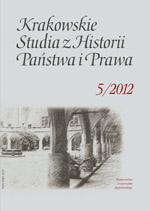Odpowiedzialność odszkodowawcza państwa za bezprawne działania jego organów według ABGB w świetle wykładni Sądu Najwyższego (1918–1939
The liability for damage caused on occasion of excercising public power. The discussion of the problem through prism of interpretation of the ABGB...
Author(s): Andrzej DziadzioSubject(s): Law, Constitution, Jurisprudence
Published by: Wydawnictwo Uniwersytetu Jagiellońskiego
Keywords: damages; liability; judiciary in the interwar Poland; Austrian law; Polish law; legal tradition
Summary/Abstract: The paper analyses the fundamentals of civil law liability of the State for the harm resulting from the excercising of public power in both the Austrian constitutional monarchy(1867-1918) as well as in the Second Republic of Poland (1918-1939). The paper is designed to demonstrate the extent to which decisions of the Austrian Supreme Tribunal in the area of compensatory liability - were reflected in the decisions of the Polish Supreme Court of the inter-war time. The possibility of survival, in this area, of the Austrian legal thought in the independent Poland was justified both by the binding force of the same Civil Code (which was the ABGB still in force until 1946 in the area of former Austrian partition) as well as by similar constitutional regulations. Both the Austrian Constitution of December 1867 as well as the Polish Constitution of March 1921 accepted the liability of State for harm done to an individual by the agencies of State power, the harm resulting from the activities of the officials who operated contrary to law. Yet the regulations of both Constitutions were deprived of executory provisions. Similiar (and partly even identic) legal state was, to a large extent, decisive of the adopting by the Polish courts of the adjudicating line characteristic of the Austrian courts. The analysis of both the Austrian as well as the Polish court decisions disclosed that in numerous cases in which compensatory claims were raised the courts tended toward the weakening of the principle of the absence of liability of the State for the harm done by its agencies as due to the shortage of the detailed provisions. The first attempt to remedy this absence was made by the Supreme Tribunal (Ober-Gerichtshof) as well as by the Tribunal of State (Reichsgericht) in the monarchical Austria. The arguments resorted to by the two Tribunals facilitated the recognition in 1931 by the Polish Supreme Court of the principle of limited liability of State Treasury for the harm done to somebody as a result of excercising the public power by the State agencies.
Journal: Krakowskie Studia z Historii Państwa i Prawa
- Issue Year: 5/2012
- Issue No: 4
- Page Range: 295-305
- Page Count: 11
- Language: Polish

